[ot-caption title=”Tilikum, the famous orca, who died on January 6, 2017, performing at SeaWorld. (via David R. Tribble, Wikimedia)”] [spacer height=”20px”]
Killer whale Tilikum died earlier this month at age 35. Tilikum was captured in 1983 in Iceland and moved to SeaWorld in 1991. He was the center of the 2013 documentary Blackfish. Blackfish covers the effects of keeping orcas like Tilikum captive in places such as SeaWorld. [spacer height=”20px”]
Many people believe that keeping killer whales at SeaWorld is an act of torture. These whales are torn apart from their families when they are just babies; the Blackfish documentary shows how the mothers cry out to their captured children. The orcas are then enclosed in a cement cell, 100 million times smaller than their normal living environment. [spacer height=”20px”]
Tilikum was the cause of three human deaths, and finally, after his death, the killer whale breeding program at SeaWorld was shut down. Tilikum was rumored to be an aggressive killer whale, but SeaWorld did not want to get rid of him because he brought in so much money, being one of the main breeding killer whales. The issue was that if he was an aggressive killer whale, his genes would carry that as well, and the whales that were bred from him would also be aggressive. Though, it is important to note that this aggression toward humans is nearly non-existent in nature, and could very well be caused by the captivity. The orca exhibit continued doing shows despite the accidents until recently, when Tilikum’s death brought the shows to an end. [spacer height=”20px”]
After watching the documentary Blackfish, I came to a realization about the immorality of these orca exhibits and about how often SeaWorld spins their stories to protect themselves. As an example, on their website, SeaWorld claims the documentary Blackfish to be nothing more than a piece of “emotionally manipulative” propaganda. [spacer height=”20px”]
Blackfish spreads awareness to people about what goes on at SeaWorld behind the scenes. SeaWorld conceals many things from the public in order to protect their reputation and keep their exhibits and shows popular and open, with the purpose of profiting. Notably, SeaWorld has claimed that collapsed dorsal fins, an indicator of severe captivity related injuries, are normal in killer whales when this phenomenon occurs in only one percent of whales in the wild and affects one hundred percent of the male orcas at SeaWorld. [spacer height=”20px”]
Although SeaWorld declined interviews, the documentary about Tilikum included interviews of previous employees, some of whom appeared shockingly oblivious. Many of the employees did not know of half of the killer whale accidents that occurred prior to or during their time at SeaWorld. [spacer height=”20px”]
The generation of killer whales currently at SeaWorld is the last, so after all this time, these tragic incidents will finally come to an end. Though the tragedies are relevant when examining the life of Tilikum, it is also important to acknowledge the suffering in which the captive whale was subjected. Many animal rights activists share the hope that Tilikum’s memory will live on and help inspire a change in the treatment of marine life. [spacer height=”20px”]
Though, SeaWorld is only one offender, and the debate over the morality of captivity does not end outside of the water. Wild orcas have an estimated maximum lifespan of up to 50 to 100 years, and the median age of death for orcas held in captivity is drastically lower, at a low nine years old. Similarly, this statistical comparison is found in elephant lives too, when comparing wild species’ life expectancies to captive ones’, which is a 10-year difference. [spacer height=”20px”]
In March of 2015, after decades of pressure from animal rights activists, Ringling Brothers and Barnum & Bailey announced that elephants would be entirely removed from their shows by 2018. Just as public outrage following Blackfish led to a decline in ticket sales at SeaWorld, outrage surrounding the treatment of the captive circus animals in the Ringling Bros. Circus was extremely detrimental to them economically. Just a few days ago, CEO Kenneth Feld announced that, due to high operating costs and declining ticket sales since the removal of the elephants, the circus “will hold its final performances in May of this year” after over 146 yeas of operation. Though the Circus’ management would tell you otherwise, many animal rights groups, notably PETA and the Humane Society, are viewing the closure as a large victory for the anti-captivity movement. [spacer height=”20px”]
With the death of Blackfish‘s Tilikum and the announcement of the Ringling Bros. Circus’ closure occurring in the same month, the issue of animal captivity has once again been thrust into the public eye. Whether or not SeaWorld will meet the same fate as the Ringling Bros. Circus is yet to be seen, as animal rights groups continue to push for the release of captive creatures, including the remaining animals at SeaWorld. [spacer height=”20px”]
Sources: Telegraph, SeaWorldCares, SeaWorldofHurt, SeaWorldFactCheck, National Oceanic and Atmospheric Administration, PETA, New York Times, CNN, Blackfish
































![Stranger Things 4: What to Expect [Warning: Contains Spoilers]](https://pcpawprint.com/wp-content/uploads/2021/11/StrangerThings4-900x473.jpeg)























































